

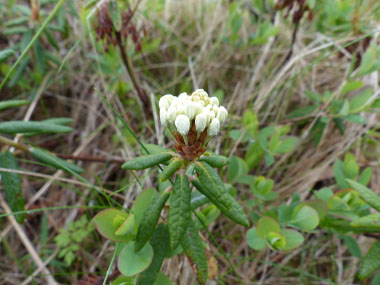
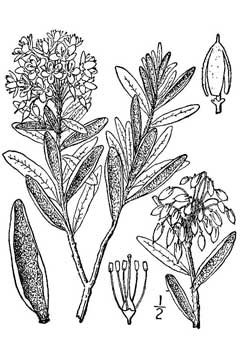

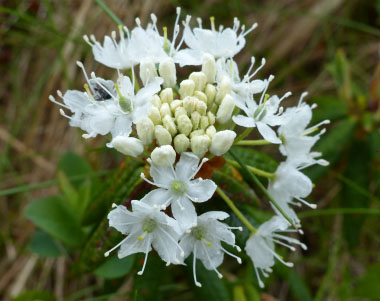


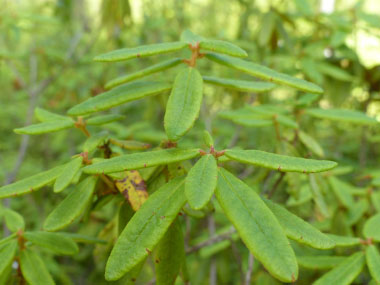
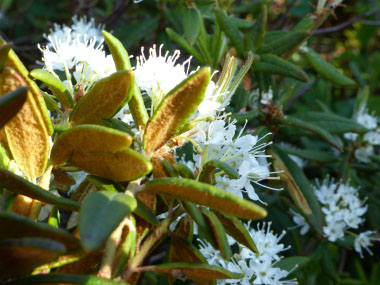
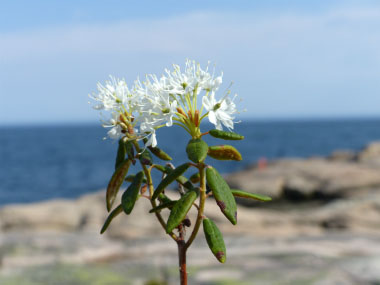
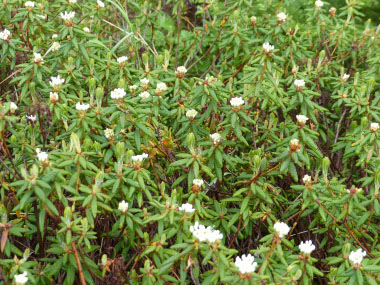
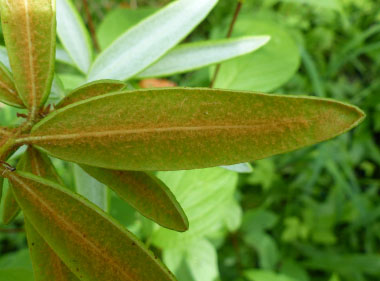
To support our efforts please browse our store (books with health benefits, etc.).
Labrador tea is a member of the heath family. This plant is a useful ecological indicator because Labrador tea is characteristic of acidic soils with high moisture and poor nutrient regimes. It is often associated with black spruce. Labrador tea is a slow growing evergreen shrub and new shoots of the season originate at the base of the flower cluster. Interestingly, this shrub can generally survive fire as the rhizomes are found deep in the organic layer and it is often found in areas too wet to burn. It is one of the first plants to re-colonize after fire and grows rapidly.
Distinguishing Features
Labrador tea is technically a flowering shrub with many erect branches, white flowers and distinctive evergreen leaves. When fully mature the leaves are very identifiable as the margins are curled under and the underneath of the leaves is rusty brown. It often grows in dense colonies. The plant spreads roots in the organic layer with rhizomes. It reproduces generally by spreading vegetatively, and less commonly, from seed.
Flowers
Several white flowers occur in showy rounded umbel-like terminal inflorescences. Individual flowers are about 1 cm across; the calyx is small and 5-toothed; the corolla is composed of 5 white ovate to oblong petals, fused at the base. There are 5 to 7 stamens and the filaments are longer than the petals. Flowers blooms in June to early July.
 Fields
of Nutrition has medicinal benefits and vitamin/mineral content of Labrador Tea.
Fields
of Nutrition has medicinal benefits and vitamin/mineral content of Labrador Tea.
Leaves
Leaves grow alternate, simple, evergreen, fragrant when crushed, and have a short-petiolate. Leaf blades are narrowly elliptic to oblong, 2 to 5 cm (1 to 2”) long and 0.5 to 2 cm wide. They have a leathery-texture, are dull and dark green above, with the lower leaf surface densely covered in matted woolly hairs that turn from white to rusty-brown at maturity. Margins are entire and slightly turned under.
Height
This plant can grow up to 1 metre (3’) tall.
Habitat
Labrador tea prefers moist to wet peaty soils, especially in bogs and wet coniferous forests; also in peaty barrens. Labrador tea is native to boreal North America. It is found in the tundra and also in drier, rocky places in the mountains.
Edible Parts
The fragrant leaves are used as a soothing tea and they have many medicinal uses. Add lemon to make an iced tea. Leaves were once used in beer making to make it heady. Flowers can also be used to make tea.
Other Name
Bog Tea.
Recipes
Winter Survival Food Handbook

PDF Plant Magazines
Types of Wild Food
Geographic Zones Seasons
Disclaimer
EdibleWildFood.com is informational in nature. While we strive to be 100% accurate, it is solely up to the reader to ensure proper plant identification. Some wild plants are poisonous or can have serious adverse health effects.
We are not health professionals, medical doctors, nor are we nutritionists. It is up to the reader to verify nutritional information and health benefits with qualified professionals for all edible plants listed in this web site. Please click here for more information.
Why Edible Wild Food?
- Food costs are rising
- Free, wild food is readily abundant
- Wild food adds nutrition to your diet
- Wild food can help treat various medical conditions





